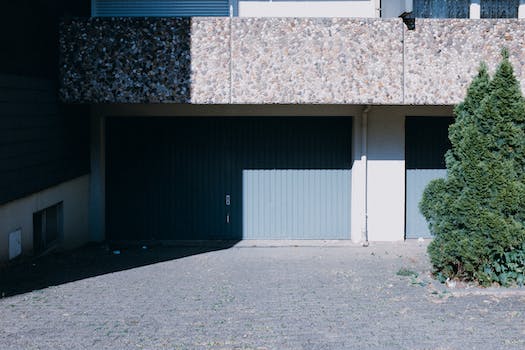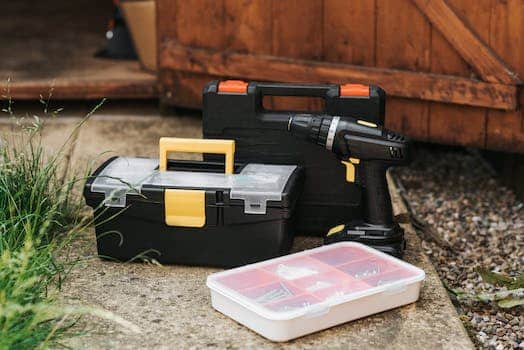Adjusting garage door springs can be a dangerous task, so it’s essential to exercise caution and follow safety guidelines. Here is a step-by-step guide to adjust garage door springs:
1. Safety first: Before starting, ensure that you have protective gear, including safety glasses and gloves.
2. Determine the spring type: Garage doors typically have two types of springs – torsion springs or extension springs. The adjustment process varies for each type, so make sure you know which one you have.
3. Release tension: To release tension from torsion springs, you’ll need to use winding bars. Insert the winding bars into the winding cone and slowly unwind the spring. Be cautious as the spring will have stored energy.
4. Adjust the torsion spring: Turn the winding cone a quarter turn at a time to make adjustments. For a door that opens too quickly, increase the tension by turning the cone in the direction that tightens the spring. To decrease tension, turn the cone in the opposite direction.
5. Test and repeat: After making adjustments, manually lift and lower the garage door a few times to check its balance and responsiveness. If further adjustments are needed, repeat steps 3 and 4 until it functions properly.
6. Adjust extension springs: Extension springs run parallel to the garage door tracks and are adjusted using the hooks at the end. To increase tension, move the hook to the next higher hole on the track bracket. To decrease tension, move it to a lower hole.
7. Test and repeat: Similar to the torsion spring, perform a manual test of the garage door to ensure the adjustments made are providing the desired effect. If required, make further adjustments by moving the hooks on the track brackets accordingly.
8. Seek professional help, if necessary: Garage door springs are under high tension, and if you’re not confident or comfortable with making the adjustments, it’s always best to hire a professional to avoid accidents or injuries.
Remember, adjusting garage door springs can be dangerous, and if at any point you feel unsure or overwhelmed, it’s always better to seek professional assistance. 
The importance of garage door springs
Garage door springs play a critical role in the smooth operation of your garage door. They are responsible for counterbalancing the weight of the door, making it easier to open and close. Without properly functioning springs, your garage door can become difficult to lift or close, posing a safety risk and causing inconvenience.
The two types of garage door springs
There are two main types of garage door springs: torsion springs and extension springs. Torsion springs are mounted horizontally above the door, while extension springs are located above the upper tracks on both sides of the door. Both types of springs function by storing and releasing tension to support the weight of the garage door.
Signs of worn-out springs
- Difficulty in opening or closing the garage door
- Loud banging or snapping noises when operating the door
- The door feels heavy when manually lifting or lowering it
- Uneven movement of the door
Why regular maintenance is essential
Regular maintenance is crucial for prolonging the lifespan of your garage door springs. Lubrication should be applied to the springs every six months to reduce friction and prevent premature wear. Additionally, visually inspecting the springs for signs of damage or wear can help you identify potential issues before they escalate into more significant problems.
What to do when springs break
If your garage door springs break, it is essential to seek professional assistance. Attempting to replace or repair them yourself can be dangerous and may cause further damage to your garage door system. A trained technician will have the necessary expertise and tools to safely replace the broken springs and restore the functionality of your garage door.
In conclusion
Garage door springs are an integral component of your garage door system. Understanding their importance, recognizing the signs of worn-out springs, and regularly maintaining them can help ensure smooth and safe operation of your garage door. Remember to seek professional help when dealing with broken springs to avoid any unnecessary risks. By taking proper care of your garage door springs, you can extend their lifespan and enjoy hassle-free operation for years to come.

Common Issues with Garage Door Springs and How to Fix Them
If you own a garage, you are probably familiar with the importance of garage door springs. These small but mighty components play a crucial role in the smooth operation of your garage door. However, like any mechanical part, garage door springs can experience issues over time. In this article, we will explore some common problems with garage door springs and provide solutions to fix them.
1. Broken Springs
One of the most common issues with garage door springs is breakage. This can happen due to wear and tear over time or from a sudden impact. You may notice that your garage door doesn’t open or close properly, or there may be visible gaps and irregular movements. If you suspect a broken spring, it is essential to address the issue promptly to avoid further damage.
To fix broken garage door springs, you will need to replace them. It is recommended to hire a professional technician for this task, as the process can be dangerous and requires specific tools and expertise. A trained technician will ensure that the new springs are installed correctly and provide you with a warranty for their work.
2. Loose Springs
Another common problem is loose garage door springs. Over time, springs can become loose due to regular usage and vibrations. Loose springs can cause your garage door to make squeaking noises or become unevenly balanced. If left untreated, this can lead to more severe issues and potentially damage other components of your garage door.
To fix loose garage door springs, you can start by tightening the bolts or nuts holding them in place. However, it is important not to overtighten them, as this can put unnecessary strain on the springs. If the problem persists, it is advisable to contact a professional technician who can accurately diagnose the issue and provide the appropriate solution.
3. Rusty Springs
Rust is another common enemy of garage door springs. Moisture and humidity can cause springs to rust over time, decreasing their effectiveness and potentially leading to breakage. If you notice signs of rust on your garage door springs, it is crucial to address the issue promptly.
To fix rusty garage door springs, you can start by cleaning them with a mild detergent and a soft brush. Be sure to remove any dirt or debris that may be contributing to the rust. After cleaning, you can apply a lubricant specifically designed for garage door springs to protect them from further corrosion. However, if the rust is extensive or if you are unsure about the condition of the springs, it is recommended to consult a professional technician.
4. Imbalanced Springs
An imbalanced garage door can be a frustrating issue. Imbalanced springs can cause your garage door to become misaligned and put strain on the other components. You may notice that your garage door opens or closes too quickly on one side or doesn’t close completely.
To fix imbalanced garage door springs, you can start by adjusting the tension of the springs. This should be done carefully, as incorrect adjustments can lead to further imbalances or damage. It is recommended to consult a professional technician who has the expertise to accurately diagnose and correct the issue.
In conclusion, garage door springs are essential components that require proper maintenance and attention. By addressing common issues such as broken springs, loose springs, rusty springs, and imbalanced springs, you can ensure the smooth and safe operation of your garage door. Regular inspections and timely repairs are key to avoiding costly repairs and extending the lifespan of your garage door.

Step-by-Step Instructions for Adjusting Garage Door Springs
Garage door springs play a crucial role in the smooth operation of your garage door. Over time, these springs may lose tension, causing your garage door to become unbalanced or difficult to open and close. In this article, we will provide detailed instructions on how to adjust your garage door springs effectively and safely.
Before we dive into the adjustment process, it’s important to understand the different types of garage door springs. There are two main types: torsion springs and extension springs. Torsion springs are typically found above the garage door, while extension springs are located above the horizontal tracks on both sides of the door.
To begin, let’s focus on adjusting torsion springs.
Adjusting Torsion Springs
Step 1: Safety First
Before attempting any adjustments, ensure that you have all the necessary safety gear, including gloves and safety glasses. It is crucial to protect yourself from potential injuries during the adjustment process.
Step 2: Gather Tools
You will need a few tools to adjust your torsion springs effectively:
| Tool | Description |
|---|---|
| Winding Bars | Used for winding and unwinding the springs |
| Adjustable Wrench | Used for loosening and tightening the winding cones |
| Clamps | Used for securing the garage door in place |
| Tape Measure | Used for measuring the spring tension |
Step 3: Release Tension
Prior to adjusting the torsion springs, you must release the tension. Start by clamping the door in place to prevent it from moving. Then, use the winding bars to unwind the tension from the springs. Make sure to release the tension gradually and with caution.
Step 4: Measure Spring Tension
Once the tension is released, use a tape measure to measure the spring tension. This step will help you determine the amount of adjustment needed to achieve the desired balance.
Step 5: Make Adjustments
Now that you have measured the spring tension, it’s time to make the necessary adjustments. Use the winding bars to tighten or loosen the springs, depending on your measurements. Remember to take small steps and test the balance of the garage door after each adjustment.
Step 6: Test and Fine-Tune
After making the initial adjustments, test the operation of the garage door. If needed, fine-tune the tension until the door opens and closes smoothly. It’s crucial to achieve the right balance to prevent any strain on the garage door opener and ensure the longevity of the springs.
Adjusting extension springs follows a slightly different process.
Adjusting Extension Springs
Step 1: Secure the Door
Start by clamping the door in place to prevent it from moving during the adjustment process. This step is essential for your safety.
Step 2: Locate Pulleys and Cables
Extension springs are usually connected to pulleys and cables. Locate these components before moving forward with the adjustment.
Step 3: Adjust Tension
To adjust the tension of extension springs, you will need to move the S-hook to different holes on the track hanger. This will increase or decrease the tension accordingly. Experiment with different hole positions to achieve the desired balance.
Step 4: Test and Fine-Tune
Once you have made the necessary adjustments, test the garage door to ensure it opens and closes smoothly. Fine-tune the tension if needed until you achieve optimal performance.
Remember, adjusting garage door springs can be dangerous if not done correctly. If you are uncertain or uncomfortable with the process, it is highly recommended to seek professional assistance. Safety should always be the top priority when working with garage door springs.
By following these step-by-step instructions, you can adjust your garage door springs effectively and ensure the smooth and safe operation of your garage door.

Safety Tips for Adjusting Garage Door Springs: What You Need to Know
Garage doors are an essential part of our homes, providing security and convenience. However, they are also heavy and operate under tension, specifically with the help of garage door springs. These springs help lift and lower the door safely and smoothly.
When it comes to adjusting garage door springs, safety should be your top priority. Incorrect adjustments can lead to accidents and injuries. In this article, we will provide you with helpful tips on how to safely adjust garage door springs.
1. Educate Yourself on the Different Types of Springs
Before attempting to adjust your garage door springs, it’s essential to familiarize yourself with the two main types: torsion springs and extension springs. Torsion springs are typically found above the closed door, while extension springs are placed above the upper horizontal tracks. Understanding the specific type of spring your garage door has will help you determine the correct adjustment method.
2. Wear Protective Gear
Safety should be your utmost priority when adjusting garage door springs. Always wear protective gear such as safety glasses, gloves, and sturdy footwear to prevent any injuries in case of accidents. Additionally, make sure you have the right tools on hand before proceeding with the adjustment process.
3. Consult the Manufacturer’s Instructions
Every garage door is different, and manufacturers provide specific instructions and guidelines for adjusting their particular springs. Take the time to read and understand the manufacturer’s instructions before attempting any adjustments. Following their recommendations will ensure proper spring adjustment and prevent any potential damage to your garage door or harm to yourself.
4. Use Caution and Test Gradually
When adjusting garage door springs, it’s crucial to exercise caution and take it slow. Gradually make small adjustments and test the door’s balance after each adjustment. This process will help you determine if further adjustments are required. If you notice any issues or the door becomes imbalanced, it’s best to seek professional help to avoid potential accidents.
5. Know When to Call a Professional
Adjusting garage door springs can be challenging and potentially dangerous if you don’t have the necessary experience or knowledge. If you feel uncertain or uncomfortable with the adjustment process, it’s always best to call a professional garage door technician. They have the expertise and tools required to safely adjust the springs and ensure your garage door operates smoothly.
In Conclusion
When it comes to adjusting garage door springs, safety should always be your priority. Familiarize yourself with the type of springs your door has, wear protective gear, and consult the manufacturer’s instructions. Take small, gradual steps during the adjustment process, and know when to seek professional help. By following these safety tips, you can ensure a safe and smooth operation of your garage door.

When to Call a Professional for Garage Door Spring Adjustment
Garage doors are an essential part of any household, providing convenience and security. However, over time, the springs that allow the door to open and close smoothly may need adjustment. While performing some minor maintenance tasks can be done by homeowners, there are instances when it becomes crucial to call a professional for garage door spring adjustment. In this article, we will discuss the signs that indicate it’s time to seek professional help and why it is essential to do so.
Signs that Indicate the Need for Professional Garage Door Spring Adjustment
1. Difficulty in Opening or Closing the Door: If you find it increasingly challenging to open or close your garage door, it may be an indication of a spring problem. Garage door springs are responsible for counterbalancing the weight of the door, and any misalignment or wear can hinder smooth operation. Calling a professional for adjustment can help prevent further damage and ensure safety.
2. Uneven Movement: Notice if your garage door moves unevenly or if one side seems higher than the other. This could mean that one of the springs is damaged or worn out. Adjusting garage door springs requires specialized knowledge and tools, making it essential to consult a professional to ensure proper alignment.
3. Loud Noises: A well-maintained garage door should operate silently. If you notice squeaking, grinding, or popping sounds while opening or closing the door, it could be a sign of a spring issue. Attempting to adjust the springs without proper expertise can lead to accidents or further damage. Therefore, it is advisable to seek professional assistance.
The Importance of Calling a Professional
1. Safety: Garage door springs are under high tension and can cause serious injuries if mishandled. Professionals have the required knowledge, experience, and tools to perform spring adjustments safely. Calling a professional ensures the safety of both you and your family.
2. Prevention of Further Damage: Garage door springs play a crucial role in the smooth operation of the door. Ignoring signs of spring issues or attempting DIY adjustments can lead to more significant problems, such as the complete failure of the springs or damage to other parts of the garage door system. Seeking professional help at the first sign of trouble can prevent costly repairs or potential accidents.
3. Save Time and Effort: Adjusting garage door springs is a complex task that requires expertise and specialized tools. By calling a professional, you can save yourself the time and effort of attempting to troubleshoot and fix the problem on your own. Professionals can swiftly diagnose the issue, make the necessary adjustments, and get your garage door working smoothly again.
In Conclusion
While some minor garage door maintenance tasks can be done by homeowners, it is crucial to know when to call a professional for garage door spring adjustment. Difficulty in opening or closing the door, uneven movement, and loud noises are all signs that indicate the need for professional assistance. By calling a professional, you ensure safety, prevent further damage, and save time and effort. Remember, it is always better to leave complex tasks to the experts when it comes to garage door springs.
SSS FAQ
1. How do I know if my garage door springs need adjustment?
If your garage door is not opening or closing smoothly, you may need to adjust the springs. Additionally, if you notice any gaps or unevenness in the door when it is closed, it could be a sign that the springs need adjustment.
2. Can I adjust the garage door springs myself?
Adjusting garage door springs can be dangerous, as they are tightly wound and under high tension. It is highly recommended to hire a professional to handle spring adjustments to avoid any potential injuries or accidents.
3. How much does it cost to adjust garage door springs?
The cost of adjusting garage door springs can vary depending on factors such as the type of springs, the extent of the adjustment needed, and the location. It is best to contact local garage door repair companies for an accurate cost estimate.
4. What tools do I need to adjust garage door springs?
Adjusting garage door springs typically requires specialized tools such as winding bars, pliers, and a ladder. It is important to have the right tools and knowledge to safely perform the adjustment.
5. How often should I adjust my garage door springs?
The need for adjusting garage door springs can vary depending on factors such as the quality of the springs and the frequency of door usage. Generally, it is recommended to have professional maintenance every 1-2 years to ensure proper functioning.
6. Can I replace the garage door springs instead of adjusting them?
If your garage door springs are damaged or worn out, it is often recommended to replace them instead of adjusting. Replacing the springs can provide better long-term solutions and ensure the safety and performance of your garage door.
7. What are the signs of worn-out garage door springs?
Signs of worn-out garage door springs can include the door not staying in place when opened or closed, excessive noise during operation, visible gaps or separation in the springs, or the door becoming unbalanced.
8. Can I adjust only one garage door spring?
While it is possible to adjust one garage door spring, it is generally recommended to adjust both springs at the same time. This helps maintain balance and ensures even and smooth operation of the door.
9. Are there any safety precautions to consider when adjusting garage door springs?
Yes, it is crucial to take proper safety precautions when adjusting garage door springs. Always wear protective eyewear and gloves, follow manufacturer instructions, and consider hiring a professional for the task to minimize the risk of injuries.
10. What should I do if my garage door springs are too tight?
If your garage door springs are too tight, it is important to avoid attempting any adjustments yourself. Overly tight springs can pose serious safety risks. Contact a professional garage door repair service to properly assess and address the issue.
11. Can I use lubrication to adjust garage door springs?
No, lubricating the springs will not adjust or fix any issues. Lubrication is typically used to reduce friction and ensure smooth operation of the garage door, but adjustments to springs require professional expertise and proper techniques.
12. What are the common types of garage door springs?
The common types of garage door springs include extension springs and torsion springs. Extension springs are typically mounted above the horizontal tracks on both sides of the door, while torsion springs are mounted on a metal shaft above the door opening.
13. How long do garage door springs last?
The lifespan of garage door springs can vary depending on factors such as usage, maintenance, and quality. On average, garage door springs can last around 7-9 years, but regular inspections and maintenance can help prolong their lifespan.
14. Can I adjust the garage door springs to make the door open higher?
Garage door springs are not typically adjusted to change the door’s opening height. Adjusting the springs is primarily done to ensure smooth and balanced operation. If you need to change the opening height, it is recommended to consult a professional.
15. What should I do if my garage door is not closing all the way?
If your garage door is not closing all the way, it may be due to issues with the springs, sensors, or other components. Contact a professional garage door repair service to properly diagnose the problem and provide the necessary adjustments or repairs.




